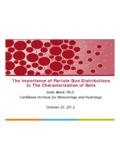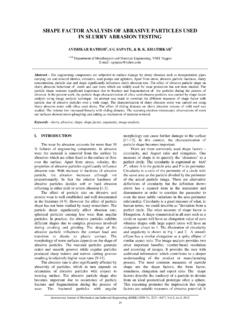Transcription of The Erosion of Metals - Cambridge Ultrasonics
1 The Erosion of Metals 1 The Erosion of Metals A dissertation submitted to the University of Cambridge for the degree of Doctor of Philosophy. David Richard Andrews Selwyn College Cambridge May 1980 The Erosion of Metals 2 Memorandum I The work described in this dissertation was carried out between October 1976 and January 1980 in the Cavendish Laboratory under the supervision of Dr J. E. Field. Unless specifically stated otherwise, all work is the result of my own research activities and none of it has been used previously in a degree thesis submitted to Cambridge University or any other university.
2 David Richard Andrews Selwyn College Cambridge The Erosion of Metals 3 Memorandum II This thesis was converted from a hard-back (paper) book into an electronic document in February and March 2015 for inclusion in the University of Cambridge s on-line library, so that a wider public may gain access to it. The process of conversion included: Optical scanning and character recognition of text. Optical scanning and creation of image files for figures. Creation of a Microsoft Word 2007 document into which text and files have been pasted.
3 Mathematical equations were recreated manually using the equation editor in Word. Similarly, references were recreated manually using Words bibliography manager. Flow diagrams were recreated using Microsoft Visio and pasted into the Word document. The creation of the Word document was done to improve the final appearance and to compress the size of the electronic thesis. The following changes have also been made: Re-formatting the greatest change to appearance by far. In a very few places one or two words were found to be missing from the original thesis and these have been added.
4 A new, short section on historical context has been added to the section titled importance of Erosion . One reference error has been corrected. In one equation the explanation of variables has been changed to reflect convention. The title of one chapter has been altered by adding a few words to reflect a discussion with one of the examiners of the thesis in 1980. Equation numbers have been altered to include the chapter in which they are first created. Generally, shortened terms like: and viz have been converted to prose.
5 In several places the use of inverted commas around words to indicate some special or unusual context has been replaced with italic letters, to conform to popular use; italic letters were not readily available to Mrs Lonzarich in 1979/80 when she typed the original thesis. The changes above were made to improve readability of the electronic thesis and have not in any way changed the scientific content. I have performed all the above tasks myself to ensure the quality of conversion. David Richard Andrews Cambridge Ultrasonics , Over, Cambridge CB24 5NX, UKThe Erosion of Metals 4 Acknowledgements I would like to thank Dr J.
6 E. Field for his help, advice and interest throughout the duration of this work. I am also deeply indebted to him for the opportunity to join the Physics and Chemistry of Solids research group of the Cavendish Laboratory. I would also like to thank Professor D. Tabor, Dr I. M. Hutchings, Dr M. Chaudhri, Dr D. Gorham, Dr J. Matthewson and Mr P. N. H. Davies for stimulating conversations concerning the work described here. May I also take this opportunity to thank the many research assistants and technicians of the Cavendish for their help with innumerable pieces of equipment but in particular Mr P.
7 N. H. Davies, Mr C. Naunton and Mr D. L. Johnson. I wish to thank the Science Research Council and United States Air Force for financial assistance. British Gas has been most generous in connection with this work by the loan of equipment - my thanks go to them and in particular to Dr M. Howe and Dr I. Glasgow. I would like to thank Rolls Royce (1971) for allowing me to visit their research laboratories at Hucknell. Lastly, but by no means least, may I thank Mrs C. Lonzarich for her patience and excellence in typing the original manuscript.
8 David Richard Andrews Selwyn College Cambridge 1980 I would also like to thank Cambridge Ultrasonics for allowing me to use its facilities for converting this thesis into electronic format and for allowing me some time away from work to perform the conversion process. David Richard Andrews Cambridge Ultrasonics Cambridge February 2015 The Erosion of Metals 5 Summary The study of the Erosion of metallic surfaces by solid particles has been an area of dispute recently (1980) especially concerning the importance of target melting as a mechanism for the removal of material.
9 In addition, Erosion by particles at a normal angle of impingement has remained unexplained and there has been no satisfactory theory of Erosion which has taken into account the statistical nature of Erosion , that is, the continual bombardment of a surface by a large number of eroding particles. This work concentrates on the foregoing aspects of Erosion . Apparatus is described which is capable of producing Erosion by single impact and continual bombardment. Conditions conducive to target melting are discussed and under equivalent experimental conditions target melting is deduced to have occurred.
10 The statistical nature of Erosion has been approached from two directions: 1. The importance of the shapes of eroding particles. 2. Considering the influence of the erosive flux on the temperature of the target and resulting Erosion rate. Material removal by single impacts at normal impingement has been observed using high-speed photography. The Erosion of Metals 6 Contents The Erosion of Metals .. 1 Memorandum I .. 2 Memorandum II .. 3 Acknowledgements .. 4 Summary .. 5 importance of Erosion .. 9 Extract from The Times 28th April 1980.





